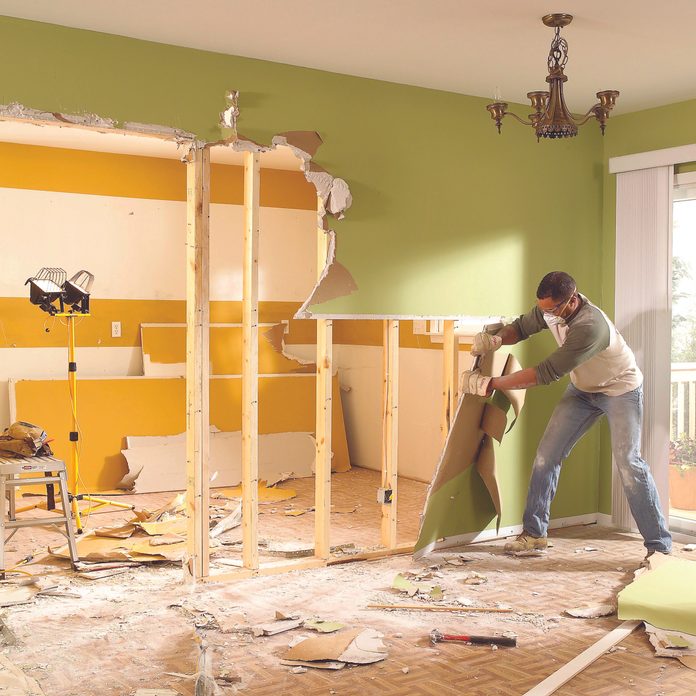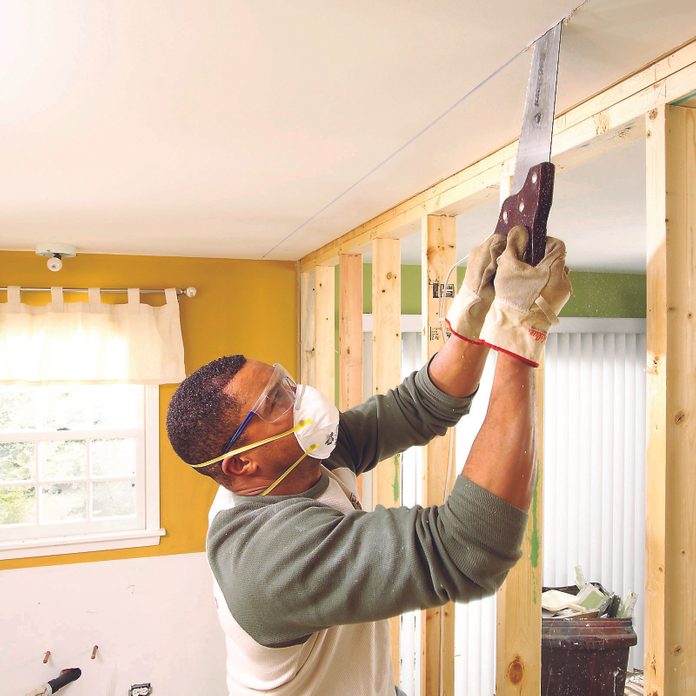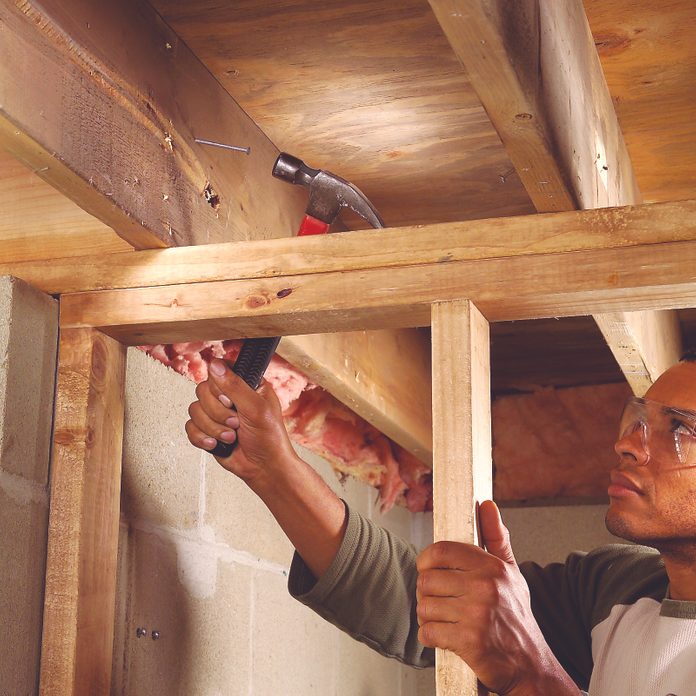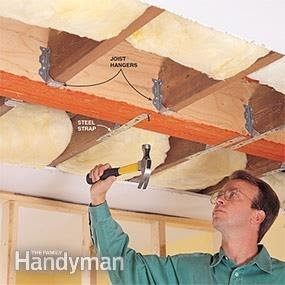How To Install A Steel I Beam In The Ceiling
How to Install a Load-Bearing Beam
Replace a load bearing wall with a microlam axle to create a bigger room.
![]() Time
Time
Multiple Days
![]() Complication
Complication
Intermediate
![]() Price
Price
$101–250
Introduction
Open up up cramped rooms by replacing a wall with a load-bearing beam. Create an open kitchen/dining area, a larger living room or a huge primary bedchamber using basic framing techniques and standard materials.
Tools Required
Materials Required
- 16d framing nails
- 2 x 4s for walls and header material
- 8d framing nails
- Construction adhesive
- Engineered beams (LVL or Gluelam)
- Joist hanger nails
- Joist hangers
The best way to make minor or cramped rooms larger is to remove a wall between bordering rooms. When you replace a load-begetting wall with a load-bearing beam, you create a larger, more useful floor area and give your home a feeling of spaciousness.
In this story, we'll evidence you how to remove nearly whatever wall and tell you lot how to add a structural beam if information technology's needed. It may be scary to recollect nigh tearing walls out of your firm, merely don't exist intimidated. You lot can practise it if you've done whatsoever basic carpentry piece of work like framing in a wall or building a shed or deck. In fact, removing the wall and replacing it with a beam will only take a half-twenty-four hour period or less.

Project footstep-by-stride (18)
Step 1
Remove the Drywall
- Shut off the circuit at the main console.
- Remove the baseboards on both sides of the wall and any electrical comprehend plates.
- Piece through the tape at within corners at the ceiling, and at any adjoining walls.
- Note: If there aren't corners nearby, make a vertical slit just beyond the wall.
- Tear off the drywall from both sides of the wall.
- Pro tip: Take off one side first by driving a hammer claw through the drywall and simply pulling a chunk complimentary. The first side volition come off in modest pieces. Loosen the drywall from the other side by rapping on the backside near the studs to free information technology from the screws. That style you lot can take off large pieces and minimize the cleanup.

Wait: Is Information technology a Load-Bearing Wall?
To tell if a wall is load-bearing, beginning check the joist direction with a stud finder. A load-bearing wall almost always has ceiling or floor framing running perpendicular to it. If y'all're unsure, ask a building contractor or your local building inspector for advice. If information technology's a load-bearing wall, the inspector may help size the axle or recommend that you have a structural engineer or architect size it. The inspector volition bank check the size, issue a permit and check your work when y'all're finished framing (before y'all start any drywall or finish work). Sometimes a full-service lumberyard will size the beam and sell it to you. In rare cases, y'all may be required to enlarge existing footings below the support columns equally well to handle the additional load. That tin get costly!
Know what's in the wall. In most cases, electric boxes and switches tin be moved or rerouted relatively easily. Only plumbing pipes and heat ducts inside the wall are cause for concern. If that'due south the case, contact a plumber and/or heating contractor to find out exactly what's involved in eliminating or moving pipes or ductwork before you offset tearing out drywall. Utilise for an electric permit if you have to movement electrical boxes or cables.
Step 2
Cut a Slot in the Ceiling
- Snap a chalk line near 12 inches out from the wall and cut a slot.
- Strip i foot of ceiling drywall from i side of the wall.
- Pro tip: Use shallow strokes to avoid nicking any electrical cables hidden in the ceiling.

Step three
Remove Cables from the Stud Wall
- Examine the ceiling framing to determine the beam blueprint.
- Turn off the electrical power and remove electric cables, outlets and switches and pull the cable free of the studs.
- Cap the ends of the exposed wires with electric connectors.

Step four
Build a Temporary Wall
- Tack a unmarried superlative 2x4 plate under the floor joists and another directly below it to the floor.
- Add a 2nd top plate.
- Tap in and toenail temporary studs every two anxiety.

Full Telescopic of the Work
DIYers are often surprised by how apace and easily the beam part went and then how extensive the rest of the job is. That work generally includes drywall patching, respraying textured ceilings, entirely repainting the new room and replacing sections of wood trim. Ordinarily, electrical outlets and switches need to be repositioned, which calls for rerouting cable and rewiring devices. If the wall contains plumbing pipes or heating vents, a plumber and a heating contractor have to be called in. And the finished flooring ever has to exist replaced. Be sure to consider all of these secondary expenses when computing the cost of your project. Most of the materials for those items are adequately inexpensive if you practise the piece of work, but information technology's all-time to get bids ahead of time for any work you plan to hire out.
Step v
Hammer Out the Sometime Studs
- Knock out the begetting wall studs with a sledgehammer.
- Bend over the leftover boom shanks in the bottom plate to protect your feet.

Step 6
Cut Off Nails Sticking Out of the Framing
- Cut continuous plates and pry them costless.
- Cut off the leftover nail shanks with a reciprocating saw.

Step seven
Remove the Backer Stud
- Cut the nails that hold the backer studs and pry them out.
- Note: You may accept to pry open up a gap with your chisel to reach the nails.
- Cutting the backer stud in half to remove it.

Footstep eight
Install the Beam Cradle
- Gather ii beam cradles from pairs of 2x4s and screw them to the tie plate and flooring with 3-inch screws.

Pace 9
Set the Beam in Identify
- Cutting the beam to length and cut notches (if necessary) to clear necktie plates in adjoining walls.
- Slip the beam members into identify and rest them on the temporary cradles.

Step 10
Shim the Beam
- Drive shims between the support studs and the lesser of the beam until the beams is tight against the underside of the necktie plate.

Stride 11
Install Trimmers Under the Beam Ends
- Cut two snug-fitting trimmers for each end of the axle.
- Tip them into place under the beam and tap them into place.
- Face or toenail each one with at to the lowest degree six 16d nails.

Footstep 12
Install the Blocking Under the Beam Ends
- Cut blocking to fit between the floor joists direct under the trimmers at the beam ends.
- Toenail and end-nail the blocks to the surrounding framing.

Step xiii
Boom the Beam and Tie Plate Together
- Toenail the beam to the tie plate and to the framing at the ends with 16d nails.
- Nail the beam members together with three 16d nails spaced every 12 inches.

Footstep xiv
Alternative: Hide the load-begetting axle in the ceiling
- If you don't similar the appearance of a load-bearing beam, you lot can hibernate it with the following steps.
Pace xv
Construct 2 Temporary Walls
- Cut an opening at 21 7/8-inch from either side of the bearing wall (assuming it's 4 ane/2-inches wide) so you end upwardly with a 48-inch opening to patch when yous're done.
- Add together the temporary walls about 3 feet. from the begetting wall.
- Tear out the bearing wall.

Stride sixteen
Cut the Joists
- Cutting out the joist where the beam will get.
- Pro tip: Leave a little actress space so the axle volition fit in easily.

Step 17
Install the Beam
- Install the beam ane LVL at a time.
- Nail the first LVL to the joists, and then boom the second to the first and so on.
- Spread heavy-duty construction adhesive betwixt the beams for extra force.
- Note:If you're installing more than than 3 LVLs, you'll accept to nail and commodities them together.

Pace 18
Hang the Joists from the Beam
- Smash joist hangers (and metal straps if specified by the engineer) to the beam and each joist.
- Pro tip: Use joist hangers that are designed to carry the size of joists y'all have (there are hangers for 2x6s, 2x8s, etc.). Use nails specially designed for joist hangers.
- And then install 2x4 trimmers inside the walls at both ends of the beam.

Additional Information
- Figure A: Begetting beam and support details
- Beam pocket at outer wall
- Beam back up at inner wall
- Support blocking in floor
- Figure B: Overview of Begetting Wall Removal
- Figure C: Collar Ties
Originally Published: Nov 09, 2022
Source: https://www.familyhandyman.com/project/how-to-install-a-loadbearing-beam/
Posted by: paulltherob.blogspot.com


0 Response to "How To Install A Steel I Beam In The Ceiling"
Post a Comment